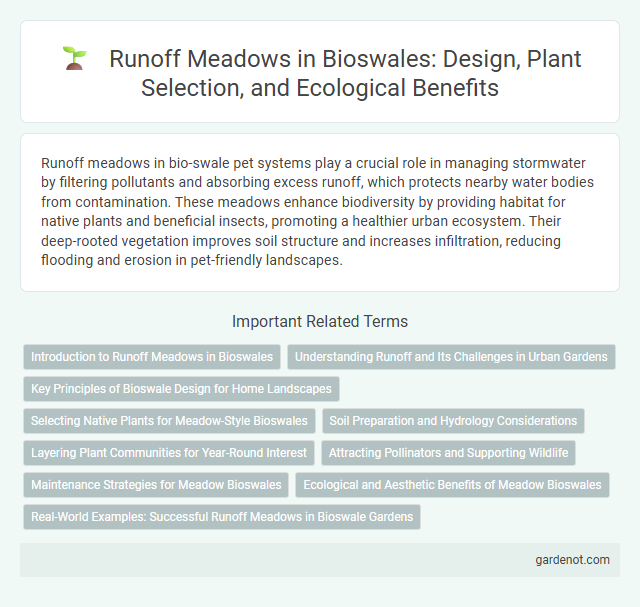Runoff meadows in bio-swale pet systems play a crucial role in managing stormwater by filtering pollutants and absorbing excess runoff, which protects nearby water bodies from contamination. These meadows enhance biodiversity by providing habitat for native plants and beneficial insects, promoting a healthier urban ecosystem. Their deep-rooted vegetation improves soil structure and increases infiltration, reducing flooding and erosion in pet-friendly landscapes.
Introduction to Runoff Meadows in Bioswales
Runoff meadows in bioswales are designed to manage stormwater by slowing, filtering, and absorbing runoff through native grasses and plants. These vegetated areas enhance water infiltration, reduce pollutants, and support groundwater recharge, improving urban water quality. Implementing runoff meadows helps mitigate flooding and promotes biodiversity by creating sustainable, natural filtration systems within urban landscapes.
Understanding Runoff and Its Challenges in Urban Gardens
Runoff in urban gardens refers to the excess stormwater that flows over surfaces like soil and pavement, often carrying pollutants such as oils, sediments, and chemicals. This uncontrollable runoff contributes to soil erosion, waterlogging, and contamination of local waterways, posing significant environmental challenges. Implementing bio-swales in runoff meadows helps to filter and absorb stormwater, reducing pollution and mitigating urban flooding effectively.
Key Principles of Bioswale Design for Home Landscapes
A runoff meadow incorporates native grasses and plants that filter and slow stormwater, reducing runoff volume and improving water quality in residential landscapes. Bioswale design for home landscapes emphasizes proper grading, selecting deep-rooted vegetation for enhanced infiltration, and ensuring adequate soil permeability to maximize groundwater recharge. Integrating mulching and erosion control techniques further stabilizes the soil while supporting sustainable stormwater management.
Selecting Native Plants for Meadow-Style Bioswales
Selecting native plants for meadow-style bioswales maximizes water infiltration and pollutant removal while supporting local biodiversity. Deep-rooted native grasses and wildflowers like switchgrass (Panicum virgatum) and black-eyed Susan (Rudbeckia hirta) enhance soil stability and runoff absorption. These species are adapted to regional climate conditions, reducing maintenance needs and promoting sustainable, resilient bioswale ecosystems.
Soil Preparation and Hydrology Considerations
Runoff meadows require careful soil preparation to enhance infiltration and support native vegetation, involving soil aeration and organic matter incorporation to increase porosity and microbial activity. Hydrology considerations include designing for appropriate slope, volume, and flow rate to efficiently capture and manage stormwater runoff while preventing erosion and promoting groundwater recharge. Selecting soil types with high permeability and ensuring proper grading are critical to maintaining optimal moisture retention and drainage in bio-swale systems.
Layering Plant Communities for Year-Round Interest
Runoff meadows utilize bio-swales with layered plant communities to effectively manage stormwater while providing ecological benefits throughout the year. Deep-rooted native grasses, perennials, and shrubs create a multi-tiered structure that enhances water infiltration, reduces erosion, and supports biodiversity. Seasonal variations in foliage, bloom, and seed heads maintain visual interest and habitat value across all seasons.
Attracting Pollinators and Supporting Wildlife
Runoff meadows in bio-swales create diverse habitats rich in native flowering plants that attract pollinators such as bees, butterflies, and hummingbirds. These environments support local wildlife by providing essential resources like nectar, pollen, and shelter. Implementing runoff meadows enhances urban biodiversity and promotes ecological balance in stormwater management systems.
Maintenance Strategies for Meadow Bioswales
Effective maintenance strategies for meadow bioswales focus on regular inspection and vegetation management to ensure optimal runoff filtration and water absorption. Routine sediment removal and controlled mowing promote healthy native plant growth, preventing invasive species and maintaining soil permeability. Integrating seasonal monitoring of soil moisture and nutrient levels supports long-term bioswale functionality and ecological balance.
Ecological and Aesthetic Benefits of Meadow Bioswales
Runoff meadows within bioswales significantly enhance urban ecosystems by improving water infiltration and supporting native biodiversity, which reduces stormwater pollution and mitigates flooding. These meadows provide habitat for pollinators and birds, contributing to ecological balance and resilience in urban landscapes. Aesthetically, meadow bioswales offer vibrant seasonal color and texture, transforming functional infrastructure into visually appealing green spaces.
Real-World Examples: Successful Runoff Meadows in Bioswale Gardens
Runoff meadows effectively capture and filter stormwater in bioswale gardens by utilizing native grasses and wildflowers that slow water flow and enhance infiltration. Notable examples include the Pier 1 Rain Garden in Seattle and the University of California's Central Campus, where runoff meadows significantly reduce surface runoff and improve water quality. These projects demonstrate measurable decreases in pollutant loads and provide vital urban habitat, showcasing the environmental and aesthetic benefits of integrating runoff meadows into bioswale designs.
Runoff meadow Infographic

 gardenot.com
gardenot.com